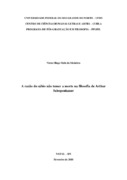Use este identificador para citar ou linkar para este item:
https://repositorio.ufrn.br/handle/123456789/25302| Título: | A razão do sábio não temer a morte na filosofia de Arthur Schopenhauer |
| Autor(es): | Medeiros, Victor Hugo Melo de |
| Orientador: | Nascimento, Dax Fonseca Moraes Paes |
| Palavras-chave: | Vontade;Sabedoria de vida;Caracterologia;Morte |
| Data do documento: | 16-Fev-2018 |
| Referência: | MEDEIROS, Victor Hugo Melo de. A razão do sábio não temer a morte na filosofia de Arthur Schopenhauer. 2018. 83f. Dissertação (Mestrado em Filosofia) - Centro de Ciências Humanas, Letras e Artes, Universidade Federal do Rio Grande do Norte, Natal, 2018. |
| Resumo: | O presente trabalho pretende investigar uma possível relação entre os temas sabedoria de vida e temor à morte na filosofia de Arthur Schopenhauer. As obras básicas analisadas serão O mundo como vontade e representação (1819-1844), tomos I e II, e os Aforismos para a sabedoria de vida (1851). No 1° capítulo, iremos fazer um resgate histórico de alguns antecedentes filosóficos do problema da sabedoria contra o temor à morte e, no último subitem, explicitaremos algumas influências de Immanuel Kant (1724-1804) na filosofia de Schopenhauer, no que concerne à distinção entre Vontade e fenômeno. No 2º capítulo, pretendemos dialogar os Aforismos para a sabedoria de vida (1851) com a caracterologia do Mundo. Primeiramente, almejamos efetuar a distinção entre razão prática e sabedoria de vida para, em segundo lugar, deixar claro que as características do sábio em Schopenhauer se encontram no Mundo, mas só são desenvolvidas nos Aforismos. No que se refere à caracterologia, ou os três modos de consideração sobre o mesmo caráter (inteligível, empírico e adquirido), serão investigadas as bases ontológicas que permitem a existência de um tipo de vida sábio e no que ele se diferencia do homem comum. No 3° capítulo, será dada ênfase às considerações que Schopenhauer realizou sobre a relação entre o homem e a morte buscando entender a origem do temor à morte e se há ou não um conhecimento que consiga aplacar esse temor. No final será feito um mapeamento dos tipos de morte presente na filosofia schopenhaueriana. |
| Abstract: | The present work intends to investigate a possible connection between the themes wisdom of life and fear of death in the philosophy of Arthur Schopenhauer. This work is based on the studies of The World as Will and Representation (1819-1844) Vol. I and II, and the Aphorisms on the Wisdom of Life (1851). In the 1st chapter, we will make a historical review of some philosophical antecedents on the problem of wisdom against the fear of death and, in the last subsection, we will explain some influences of Immanuel Kant (1724-1804) on the philosophy of Schopenhauer concerning the distinction between Will and Phenomenon. In the 2nd chapter, we intend to cross the Aphorism on the Wisdom of Life (1851) and characterology of the World. Initially, we aim to distinguish the practical reason from the wisdom of life, then we are going to clarify that the characteristics of the Wise in Schopenhauer’s work can be found in The World, but they can only be developed on the Aphorisms. Regarding the Characterology, or the three ways of acknowledging the same character (intelligible, empirical and acquired), it will be investigated the ontological bases which provide the existence of the Wise and what distinguish it from the regular human. In the 3rd chapter, we will emphasize the considerations of Schopenhauer regarding the relation between Men and Death, seeking to understand the origin of the fear of death and if there is any wisdom capable of easing this fear. At the end, we will make a mapping of the types of death present in Schopenhauerian philosophy. |
| URI: | https://repositorio.ufrn.br/jspui/handle/123456789/25302 |
| Aparece nas coleções: | PPGFIL - Mestrado em Filosofia |
Arquivos associados a este item:
| Arquivo | Descrição | Tamanho | Formato | |
|---|---|---|---|---|
| VictorHugoMeloDeMedeiros_DISSERT.pdf | 910 kB | Adobe PDF |  Visualizar/Abrir |
Os itens no repositório estão protegidos por copyright, com todos os direitos reservados, salvo quando é indicado o contrário.

